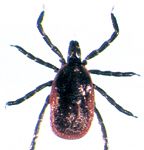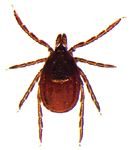ClinQuiz: Fast tick facts
Test your knowledge of ticks and tick-borne diseases with this short quiz.

Figure 1
1) A 3-year-old mixed-breed spayed female dog presents with fever, depression, and ocular discharge. On physical examination, the dog is in pain and has moderate muscle atrophy of the right hindlimb. A complete blood count reveals severe neutrophilic leukocytosis with gamonts seen in leukocytes in a Giemsa-stained blood smear (see Figure 1). How did the dog most likely become infected with this parasite?
C. Ingestion of an infected tick
2) You are practicing in a rural area in western Arkansas, one of the top five states for reported cases of Rocky Mountain spotted fever. A client with two dogs and two children who is concerned about Rocky Mountain spotted fever mentions that she checks the children and dogs once a day, removing all attached ticks, as she is aware that tick-borne diseases cannot be transmitted in less than 48 hours. How do you respond?

Figure 2
3) You move from a practice in New York to one in Georgia and find that the protocols at the new practice do not recommend routinely vaccinating dogs against Borrelia burgdorferi, the agent of Lyme borreliosis. Routine vaccination of all dogs followed by annual boosters was stressed at your former practice. What do you think most likely accounts for the difference in vaccination protocol recommendations?
4) A client with three adult German shepherds calls for advice because his home is heavily infested with ticks. He has seen ticks crawling on the walls and in and out of the acoustic tiles in the dropped ceiling in his basement. This morning, he stepped on an engorged female tick on the kitchen floor while on his way to make coffee. He occasionally finds ticks on the dogs but never on himself or his cats. Which of the following ticks is most likely infesting this home?



Figure A
Figure B
Figure C
A. The lone star tick, Amblyomma americanum (see Figure A)
B. Ixodes scapularis, the deer tick or blacklegged tick (see Figure B)
C. The brown dog tick, or kennel tick, Rhipicephalus sanguineus (see Figure C)
5) A client comes in on a Monday morning in late April with her two Weimaraners. She took them backpacking in North Carolina over the weekend. They both have a few lone star ticks attached. She is upset because she has been applying a monthly acaricide, which she obtains from your practice. The last application was two weeks ago, and she has not bathed the dogs. She would like an explanation for why the treatment failed to keep her dogs tick-free. Which of the following explanations most likely accounts for the fact that ticks are attached to these dogs?
B. Amblyomma americanum has recently been shown to be resistant to commonly used acaricides.

Susan E. Little, DVM, PhD, DEVPC
This quiz was provided by Susan E. Little, DVM, PhD, DEVPC, Department of Veterinary Pathobiology, Center for Veterinary Health Sciences, Oklahoma State University, Stillwater, OK 74078.